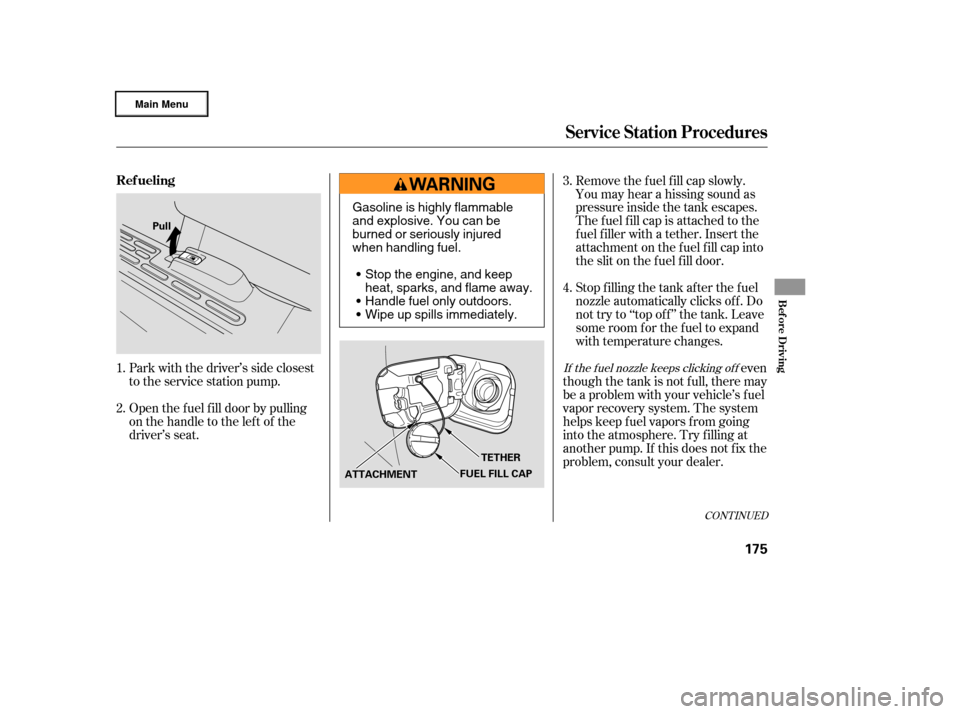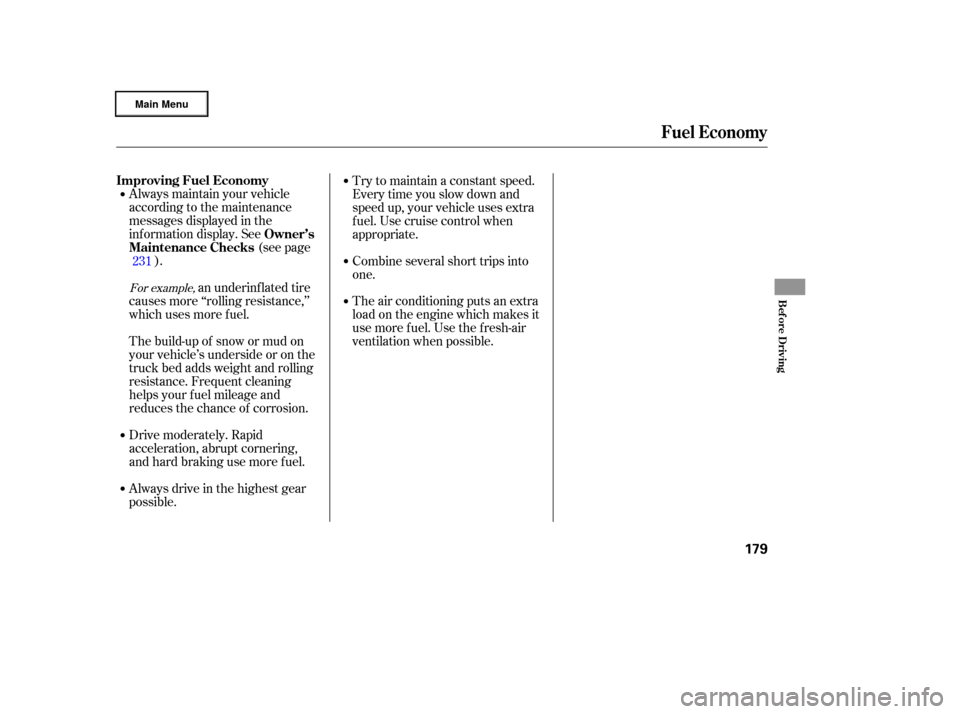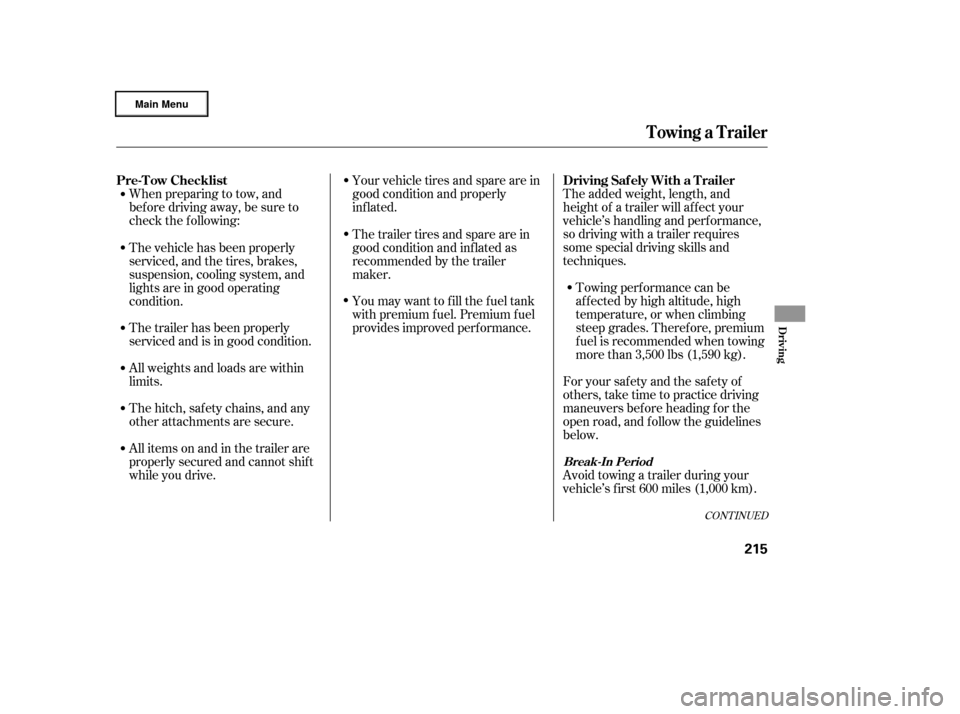Page 73 of 320

If your f uel f ill cap is loose or
missing, a ‘‘CHECK FUEL CAP’’
message appears in the odometer
display af ter you start the engine.
The message goes f rom CHECK to
FUEL CAP repeatedly. You will also
hear a beep.
Turn the engine of f , and conf irm the
f uel f ill cap is installed. If it is, loosen
the cap, then retighten it at least 3
clicks. When you restart the engine,
the message appears again. To clear
the message, press and hold the
RESET button until the odometer
display returns.If the system still detects a loose or
missing f uel f ill cap, the malf unction
indicator lamp (MIL) comes on.
Turn the engine of f , and check or
retighten the f uel f ill cap at least 3
clicks. The MIL goes out af ter 3 days
of normal driving once the cap is
tightened or replaced. If it does not
go out, have your dealer inspect the
vehicle. For more inf ormation, see
page .
The inf ormation display in the
instrument panel shows you the
engine oil lif e and maintenance
service items when the ignition
switch is in the ON (II) position. This
inf ormation helps to keep you aware
of the periodic maintenance your
vehicle needs f or continued trouble-
f ree driving. Ref er to page f or
more inf ormation.
279 225
Check Fuel Cap Indicator Maintenance Minder Display
Gauges
70
�����—�
���—�����y�
�������������y���
�(�����������y���������y
Page 176 of 320
Bef ore you begin driving your
vehicle, you should know what
gasoline to use and how to check the
levels of important f luids. You also
need to know how to properly store
luggage or packages. The
inf ormation in this section will help
you. If you plan to add any
accessories to your vehicle, please
read the information in this section
first..............................
Break-in Period .174
.................
Fuel Recommendation .174
.........
Service Station Procedures .175
....................................
Ref ueling .175
Opening and Closing the
.......................................
Hood .177
...................................
Oil Check .178
.............
Engine Coolant Check .178
...............................
Fuel Economy .179
...
Accessories and Modif ications .180
.............................
Carrying Cargo .182
Bef ore Driving
Bef ore Driving
173
�����—�
���—�����y�
���������
���y���
�(�����������y���
�����y
Page 177 of 320

Help assure your vehicle’s f uture
reliability and perf ormance by paying
extra attention to how you drive
during the f irst 600 miles (1,000 km).
During this period:Avoid full-throttle starts and rapid
acceleration.
Do not change the oil until the
scheduled maintenance time. Avoidhardbrakingforthefirst
200 miles (300 km).
Do not tow a trailer.
You should also f ollow these
recommendations with an
overhauled or exchanged engine, or
when the brakes are replaced. Your vehicle is designed to operate
on unleaded gasoline with a pump
octane number of 86 or higher. Use
of a lower octane gasoline can cause
a persistent, heavy metallic rapping
noise that can lead to engine damage.
We recommended using a quality
gasoline containing detergent
additives that help prevent fuel
system and engine deposits.
In addition, in order to maintain good
perf ormance, f uel economy, and
emissions control, we strongly
recommend, in areas where it is
available, the use of gasoline that
does NOT contain manganese-based
f uel additives such as MMT.
Use of gasoline with these additives
may adversely af f ect perf ormance,
and cause the malfunction indicator
lamp on your instrument panel to
come on. If this happens, contactyour authorized dealer f or service.
Some gasoline today is blended with
oxygenates such as ethanol or
MTBE. Your vehicle is designed to
operate on oxygenated gasoline
containing up to 10 percent ethanol
by volume and up to 15 percent
MTBE by volume. Do not use
gasoline containing methanol.
If you notice any undesirable
operating symptoms, try another
service station or switch to another
brand of gasoline.
Premium f uel is recommended when
towing in certain conditions (see
page ).
For f urther important f uel-related
inf ormation, please ref er to your
.
215
Break-in Period Fuel Recommendation
Quick Start Guide
Break-in Period, Fuel Recommendation
174
�����—�
���—�����y�
�������������y���
�(�����������y���
�����y
Page 178 of 320

CONT INUED
Open the f uel f ill door by pulling
onthehandletotheleftof the
driver’s seat. Park with the driver’s side closest
to the service station pump.Stop f illing the tank af ter the f uel
nozzle automatically clicks of f . Do
not try to ‘‘top of f ’’ the tank. Leave
some room f or the f uel to expand
with temperature changes. Remove the f uel f ill cap slowly.
You may hear a hissing sound as
pressure inside the tank escapes.
The fuel fill cap is attached to the
f uel f iller with a tether. Insert the
attachment on the fuel fill cap into
the slit on the f uel f ill door.
even
though the tank is not full, there may
be a problem with your vehicle’s f uel
vapor recovery system. The system
helps keep f uel vapors f rom going
into the atmosphere. Try f illing at
another pump. If this does not f ix the
problem, consult your dealer.
1.
2. 3.
4.
If the f uel nozzle keeps clicking of f
Ref ueling
Service Station Procedures
Bef ore Driving
175
Pull
TETHER
FUEL FILL CAP
ATTACHMENT
Gasoline is highly flammable
and explosive. You can be
burned or seriously injured
when handling fuel.
Stop the engine, and keep
heat, sparks, and flame away.
Handle fuel only outdoors.
Wipe up spills immediately.
�����—�����—�����y�
����
��������y���
�(�����������y���
�����y
Page 179 of 320

Whenever f illing a f uel container,
use an approved f uel container, and
place it on the ground. Do not f ill the
f uel container in the vehicle,
including the pickup bed and the
In-Bed Trunk. Make sure to put the
f uel pump nozzle in the f uel f iller of
the container securely and to handle
it properly.
Your vehicle has a warning label f or
f illing a portable f uel container on
the lef t rear side of the pickup bed. Before placing the fuel container in
the vehicle, wipe up any spill
completely. Gasoline or f uel vapors are
extremely f lammable and explosive.
Improperly handling f uel can cause
the explosion in which you can be
seriously injured.
Screw the fuel fill cap back on
until it clicks. If you do not
properly tighten the cap, the
malf unction indicator lamp may
come on (see page ). You will
also see a ‘‘CHECK FUEL CAP’’
message on the odometer display.
Push the f uel f ill door closed until
it latches.
5.
6.
279
Service Station Procedures
Filling a Port able Fuel Cont ainer
176
Do not fill a portable fuel
container in the pickup bed.
Static electricity can ignite gas
vapors and you can be burned.
�����—�����—�����y�
����
��������y���
�(�����������y���
���
�y
Page 182 of 320

Always maintain your vehicle
according to the maintenance
messages displayed in the
inf ormation display. See(see page
).
an underinf lated tire
causes more ‘‘rolling resistance,’’
which uses more f uel.
The build-up of snow or mud on
your vehicle’s underside or on the
truck bed adds weight and rolling
resistance. Frequent cleaning
helps your f uel mileage and
reduces the chance of corrosion.
Drive moderately. Rapid
acceleration, abrupt cornering,
and hard braking use more f uel.
Always drive in the highest gear
possible. Try to maintain a constant speed.
Everytimeyouslowdownand
speed up, your vehicle uses extra
f uel. Use cruise control when
appropriate.
Combine several short trips into
one.
The air conditioning puts an extra
load on the engine which makes it
usemorefuel.Usethefresh-air
ventilation when possible.
231
For example,
Improving Fuel Economy
Owner’s
Maintenance Checks
Fuel Economy
Bef ore Driving
179
�����—�
���—�����y�
�������������y���
�(�����������y���
�����y
Page 218 of 320

The added weight, length, and
height of a trailer will af f ect your
vehicle’s handling and perf ormance,
so driving with a trailer requires
some special driving skills and
techniques.
Your vehicle tires and spare are in
good condition and properly
inf lated.
When preparing to tow, and
bef ore driving away, be sure to
check the f ollowing:
Foryoursafetyandthesafetyof
others,taketimetopracticedriving
maneuvers bef ore heading f or the
open road, and f ollow the guidelines
below.Towing perf ormance can be
af f ected by high altitude, high
temperature, or when climbing
steep grades. Theref ore, premium
fuelisrecommendedwhentowing
more than 3,500 lbs (1,590 kg).
Avoid towing a trailer during your
vehicle’s f irst 600 miles (1,000 km).
The trailer tires and spare are in
good condition and inf lated as
recommended by the trailer
maker.
You may want to fill the fuel tank
with premium f uel. Premium f uel
provides improved perf ormance.
The vehicle has been properly
serviced, and the tires, brakes,
suspension, cooling system, and
lights are in good operating
condition.
The trailer has been properly
serviced and is in good condition.
All weights and loads are within
limits.
Thehitch,safetychains,andany
other attachments are secure.
Allitemsonandinthetrailerare
properly secured and cannot shif t
while you drive.
CONT INUED
Driving Saf ely With a T railer
Pre-T ow Checklist
Towing a Trailer
Break-In Period
Driving
215
�����—�
���—�����y�
������
������y���
�(�����������y���������y
Page 234 of 320
�µ�µ�µ
�µ
�µ �µ
Youshouldcheckthefollowing
items at the specif ied intervals. If
you are unsure of how to perf orm
any check, turn to the appropriate
page listed.
Engine oil level Check every
time you fill the fuel tank. See
page .
Engine coolant level Check the
radiator reserve tank every time
you f ill the f uel tank. See page .
Automatic transmission Check
the f luid level monthly. See page .
Brakes Check the f luid level
monthly. See page .
Tires Check the tire pressure
monthly. Examine the tread f or
wear and foreign objects. See page . Lights Check the operation of
the headlights, parking lights,
taillights, high-mount brake light,
and license plate lights monthly.
See page .
256 245
178 178
241 243
CONT INUED
Maintenance Minder
Owner’s Maintenance Checks
Maint enance
231
�����—�
���—�����y�
���������
���y���
�(�����������y���������y